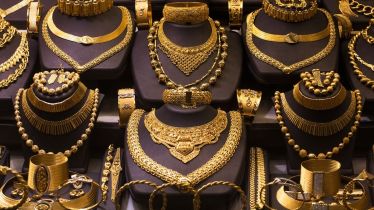Diwali, the festival of lights is just around the corner and the air seems to vibrate with a palpable celebratory energy. Families all over India are making checklists and preparing to shop for the upcoming revelries. While new outfits, puja essentials, groceries and new appliances are a priority, purchasing gold at this time is just as important to Indians. Every year Indians purchase massive amounts of gold, dwarfing the country’s official reserves. According to a Business Today report, India’s private gold stash is estimated to be a whopping 25,000 tonnes. Indians definitely take the gold-buying business seriously.
Gold is especially bought on Dhanteras, which occurs a few days before Diwali. This year, Diwali is going to take place on Monday, Oct 20 while Dhanteras will take place on Saturday, Oct 18. Dhanteras is considered very auspicious for the purchase of gold or any other precious metals as it is believed that buying gold on this day attracts the blessings of Goddess Laxmi. Said blessings are supposed to multiply the wealth of the buyer and their families for the whole year. This is a time-old tradition and one that people believe in and practice even today. It also sorts out asset allocation and finances for the year. So, while a tradition it also has a practical motive to it.
A quick lesson on gold purity
Buying gold requires one to have adequate knowledge of gold purity and all that it entails otherwise there maybe a risk of getting cheated and not getting your money’s worth. Armed with the knowledge of what gold purity encompasses, one can make better and informed decisions. The first thing to keep in mind is Karats. Gold purity is measured in Karats and the higher the Karat the purer the gold, and inversely the lower the Karat, the higher the possibility of the gold being an alloy, mixed with metals like silver or copper. For example: 24K means it is pure gold or 99.9% pure while 18K means it is 75% pure. Buyers can choose the Karats according to their budget and preferences. It is to be noted that pure gold is extremely soft and malleable, so mixing other metals to create an alloy is sometimes required to increase durability, especially when it comes to daily-wear jewellery.
Fineness is another way in which one can understand gold purity. It is a measure of gold purity expressed in parts per thousand, indicating how much pure gold is present in an alloy. For instance, 24K gold has a fineness of 999 while 18K has a fineness of 750, this indicates that 24k gold is 99.9% pure gold while 18k is 75% pure gold. Fineness and Karats are both used to measure gold purity but fineness is more precise.
How to verify purity and hallmark: a guide
Now that you know how to measure gold purity, the next step is to know how to verify the authenticity of it’s pureness and identify the hallmark which proves that it is genuine. The most important thing to spot when buying gold is the BIS stamp. In India, the Bureau of Indian Standards (BIS) authenticates gold with a hallmark stamp. The stamp contains the following details: the BIS logo, the purity of gold, the hallmark number and the hallmarking year. Apart from the BIS mark, the gold should also have a HUID code (Hallmark Unique Identification number) which is unique to every gold item produced and alphanumeric in nature.
Apart from the BIS mark, if there is still some doubt regarding the purity of gold, one can go for the following tests at their own risk. The first test is the acid test, which must only be done by a specialist as there is a risk of damaging the gold. Though it is one of the most common tests it is also tricky. Jewellers use a small drop of nitric acid on a tiny scratch made on the surface of the gold to reveal its purity. 100% pure and genuine gold will not react as it is a noble metal while fake or impure gold will turn green or milky.
The second test is the magnet test. Gold is not magnetic so bringing a strong magnet close to it should do nothing, whereas if there are other magnetic metals mixed in the alloy the piece is bound to stick to the magnet. This mainly determines if the “gold” is fake rather than to check the accuracy of purity as gold alloys are common. The third test is the density test where discerning the weight and volume of the gold can help determine purity. The method involves weighing the gold, submerging it in water to measure displacement and diving the weight by the volume to get the density. Pure gold has a density of close to 19.3 cubic centimeter. These are the more traditional methods
Other methods involve the usage of electronic equipment such as X Ray Fluorescence (XRF), Electronic testers and Ultrasonic testers. These methods are also highly accurate but need to be done by professional jewellers as they have the tools required to get the most accurate results. Enquire with your jeweler to see if they do such tests.
As they say, “knowledge is power”, With the right knowledge and guidance, buying gold can be a walk in the part. So this festive season, do your research, keep an eye out for authentic gold and spend your money wisely.
